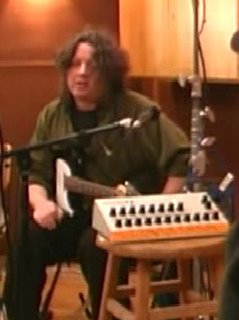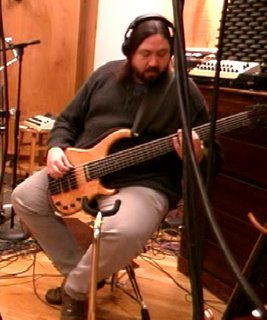
Tracking
by Dave Schools
Feb. 10, 1999 Keane Studio, Ltd. Athens, GA

Part 2: TRACKING
Last week we went into great detail concerning the process of "setup."
Harsh, wasn't it?
This time we go into the process of tracking or the actual recording of
sounds to tape. Now that all the instruments have been tuned, isolated,
and recording levels have been perfected it is time to begin recording.
For this project John Keane has replaced his 32 track Otari analog
recorder with a Sony 48 track digital machine and augmented his usual mass
of compressors, equalizers, and other devices with even more of the same.
As I mentioned earlier, John had really wanted to be a "hands on" producer
for this project and had therefore brought in the highly competent
Bradshaw Leigh to tweak the sounds and push the faders. John's
ultra-versatile assistant Rob Haddock was always on hand to do the dirty
work like changing tape reels or running microphones. This way John could
be free to really concentrate on the idea facet of production.
We were chomping at the bit to begin cutting some tracks so when the call
finally came we were more than happy to leave the TV room (despite an
exceptionally funny episode of Animaniacs) and get into the hot main
recording room. We were set up in a semi-circle with Todd in the corner,
me to his right, Mikey, JB, and Jojo completing the circle back around the
room to Todd's left. Sunny's antics could be witnessed through the plate
glass window between Mikey and myself. The first song is usually somewhat
of a warm-up to get levels tweaked even more not only in our headphone
mixes but also in the control room. Sometimes some real magic can happen
in those first few runs of a tune. For instance, "Hope In A Hopeless
World" from the last CD was really just a warm-up, but John was so taken
with its energy that it became the first "keeper" of that session and went
on to become the most successful single of our career to that point.
This time the first attempt was "All Time Low," and it's energy was
probably a little over the top. We played it three more times and got a
version that we were pretty happy with. Thus began the process of
tracking. Now at this point it is necessary for me to make a tough
decision: should I as a chronicler of this process allow you, the readers,
to know what songs we have recorded for this project? I'm pretty sure I
know what your answer to that question would be, but I must tell you that
I will not divulge the contents of this yet untitled project. Sorry, but I
like a good surprise as well as anyone. I will tell you that we cut 13
songs that you have heard before, 4 jams that will become songs during the
recording process, and three covers: two for fun and one to go on a
tribute album for a certain band we all know and either love or hate. But
that's as far as I can go. I will only refer to these tunes as just that:
tunes.
So back to task at hand. Perhaps you have heard the old saw: "Hurry up and
wait." Let me tell you that no one is more familiar with the meaning of it
than musicians and their hard-working crew. There is always a hurry, a
rush, to get to where you are supposed to be at a precise time. Of course,
once you arrive you sit around twiddling your thumbs for an hour. This is
true of the live arena and no more so than in the studio. There is always
something to hold you up and delay the sound of John's voice coming
through the headphones saying; "It's rolling." Drums are the main concern
at this point in tracking and this is why: All other performances (vocals,
guitars, bass, and percussion) are pretty expendable meaning only that
they can be replaced (or overdubbed) later. What the producer is concerned
with is getting a good feeling drum track that Todd is happy with. But
just when you are ready to count off the intro for a take John or Rob will
burst through the door to tune up the tom tom head or adjust the overhead
microphones, or heaven help us, change the snare drum entirely. This last
option is one of the most feared for it entails waiting around for another
twenty minute while the new snare head is tuned to the proper pitch. This
is why there are so many photos of us just sitting around accompanying
these diary entries.
Thus, all the pressure lies upon Todd during this point. Drum tracks
usually consist of many different sounds. This includes the snare, kick,
hi hat, tom toms, and overhead microphones. The fact that the drummer is
indeed the foundation of all the rest of the sounds you hear prevents him
from having the luxury of overdubbing his part later. We all need Todd to
be the rock we know so that we can have him as a living metronome for our
parts during the overdubbing and fix-it part of the recording. And I will
say that Todd outdid himself this time. He can always be counted on to lay
down a solid, steady beat for all songs, always. But this time, by the end
of the first week, we had cut nearly twenty keeper tracks. He saved us
from succumbing to the restless tedium of "hurry up and wait" and allowed
us and John the luxury of having more time to concentrate on arrangements
and new musical ideas. Todd gets the gold star for the session indeed.
While the tracking is going on there is always time for sitting around and
listening to previously recorded tracks in the back room, discussing new
arrangement ideas, or doing interviews. Sometimes our friends drop by to
check up on us or just to have a little fun. Kevn Kinny brought us a
bottle of wine, Vic Chesnutt rolled up to hang out, and Randall Bramblett
brought Roger Glover by to say howdy. Who the hell is Roger Glover you may
ask? Well, my friends, he was the bass player for Deep Purple during the
incredible "Smoke On The Water" period of that band. He is also one of my
big influences. Just listen to the bass line on the live version of "Space
Truckin'" from the Made In Japan album. I was really glad to meet him and
in my rush of excitement in meeting him never even thought it was odd that
he would be in Athens. Randall explained that Roger had heard his latest
CD and been so taken with it that he called him up out of the blue to come
to Athens and work on some songs with him.
Other friends come to the studio to cut guest tracks on the album. In the
past we have had the Memphis Horns, David Blackmon, Vic Chesnutt, Daniel
Hutchins and Eric Carter of Bloodkin, and a host of others in to augment
our sounds. This project is no different, as we have had Colin Butler from
Big Ass Truck in to whip out some turntable magic, The Dirty Dozen Horns,
and even a gospel choir.
One thing that often happens during tracking is a certain amount of
rearranging of the parts of a song. For instance a verse or chorus may be
removed or added as the case warrants or a bridge may be added to create a
change in the tempo or feel of a song. Case in point: by the time we
settled on the final arrangement of "Wondering" we had gone through over
forty takes in three different studios. For the most part we run into two
situations when arranging songs. One is the case where we have been
playing a song live for so long that we are, in a sense "married" to it's
arrangement. It can be difficult to change something that we are so
accustomed to and we usually wind up abandoning any ideas along those
lines. The other instance is when we are actually composing a new song in
the studio. In this case it's easy to work out new ideas because, in
addition to the song being fresh, there is a shared feeling of excitement.
I know I speak for all six of us when I say one of the most rewarding
things that can happen during tracking is when John Keane actually gets
excited by a new song. It's almost as if you see a cartoon light bulb
flashing and hovering above his head. This is when things can really start
happening. For instance, when Mikey recorded the demo for "Raise The
Roof." you could see the wheels turning in John's head and the glimmer in
his eyes doubling in intensity.
We ourselves could never have conceived the alien four part harmonies or
the synthesizer pad that John added to that song. This is a great example
of hands-on producing the ability to add something truly unique to the
recorded version of a song. Let me just say that this rare occurrence has
happened several times already with this session. There is a feeling of
excitement going on here like I have never felt before.
Once all the drum takes have been captured on tape, we rejoice because it
is the time when the studio fun begins. We also rejoice because we realize
that we have recorded way too many songs to fit on one CD. It may be a
difficult decision to set half of these songs aside for another project,
but it beats the hell out of not having enough material at all. Todd
basically goes on call and I get the distinct honor of having my bass
parts put under the microscope for hyper-scrutiny by John. This can be a
real ego-buster as you hear your sloppy technique or off-color notes come
flying out of the studio monitors as John halts the tape and says with a
grin, "I guess we should fix that whole section." But this is the wonder
of modern recording technology: these little problems can be fixed.
In some cases it is necessary to re-record the entire track, sometimes the
wrong note can be "punched in." Punching in is a technique where the
recording engineer pops the machine into record mode while you play the
correct note or notes (hopefully). He can get the machine in and out of
record mode without corrupting any right notes you played in the original
take. John has a fast punch finger (sometimes it's just one note to be
fixed and leaving the machine in record mode for a split second too long
can ruin the original part) but no one can pull off the quick punch faster
than Johnny Sandlin. I like to compare punching in to a gunslinger and the
quick draw and Johnny to the fastest gun in the east.
It usually takes me a few days to fix my bass flubs. But other than fixing
my mistakes this is also my chance to try out other sounds or ideas. I may
decide to try out a different bass like my fretless or the electric stand
up which no one has ever seen me play before but will hear (thanks to Jane
McNall at Modulus). On the Everyday CD I played harmony bass parts in the
song "Diner" during the "hanging in the light" section. One was the
"regular" bass line and the other was a fifth harmony performed on the
fretless. This is what is great about the studio versus live: you can pull
off physically impossible feats and take your part in any direction you
please, and if it doesn't fit then you can do something different.
Coming in the next installment:
Everybody gets put under John Keane's microscope.
The terror of recording background vocals.
Preparing for "mixdown."
Some comments from the rest of the boys and John Keane.








